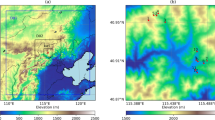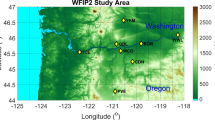Abstract
Numerical weather prediction (NWP) models have always presented large forecasting errors of surface wind speeds over regions with complex terrain. In this study, surface wind forecasts from an operational NWP model, the SMS-WARR (Shanghai Meteorological Service-WRF ADAS Rapid Refresh System), are analyzed to quantitatively reveal the relationships between the forecasted surface wind speed errors and terrain features, with the intent of providing clues to better apply the NWP model to complex terrain regions. The terrain features are described by three parameters: the standard deviation of the model grid-scale orography, terrain height error of the model, and slope angle. The results show that the forecast bias has a unimodal distribution with a change in the standard deviation of orography. The minimum ME (the mean value of bias) is 1.2 m s−1 when the standard deviation is between 60 and 70 m. A positive correlation exists between bias and terrain height error, with the ME increasing by 10%–30% for every 200 m increase in terrain height error. The ME decreases by 65.6% when slope angle increases from (0.5°–1.5°) to larger than 3.5° for uphill winds but increases by 35.4% when the absolute value of slope angle increases from (0.5°–1.5°) to (2.5°–3.5°) for downhill winds. Several sensitivity experiments are carried out with a model output statistical (MOS) calibration model for surface wind speeds and ME (RMSE) has been reduced by 90% (30%) by introducing terrain parameters, demonstrating the value of this study.
摘要
当前数值天气预报模式在复杂地形区域的地面风速预报中存在较大误差. 本研究以上海快速更新同化数值预报系统为代表, 分析了模式近地面风速预报误差与地形特征之间的关联性. 研究引入了三个描述地形特征的参数: 网格尺度模式地形标准差、 模式地形高度误差和坡度. 研究结果表明, 预报误差随地形标准差的增大呈单峰变化, 误差平均值(ME)的最小值1.2 m s−1出现在标准差在60–70 m之间; 预报误差与模式地形高度误差呈正相关, 地形高度误差每增加200 m, ME增加10%–30%. 上坡时, 当坡度从(0.5°–1.5°)增大到大于3.5°时, ME减小65.6%; 下坡时, 当坡度绝对值从(0.5°–1.5°)增大到(2.5°–3.5°)时, ME增大35.4%. 在上述分析的基础上建立了模式近地面风速的统计订正模型, 评估表明引入地形参数使ME(RMSE)降低了90%(30%), 显著地提高了模式近地面风速的预报准确率.
Similar content being viewed by others
References
Bai, L., X. Wu, Y. Y. Ding, J. Ding, and Y. R. Jiang, 2013: Hourly wind speed forecasting for wind farm power prediction. Meteorological Science and Technology, 41(4), 777–783, https://doi.org/16.3969/j.issn.1671-6205.2013.04.030. (in Chinese with English abstract)
Bauer, P., A. Thorpe, and G. Brunet, 2015: The quiet revolution of numerical weather prediction. Nature, 525(7567), 47–55, https://doi.org/10.1038/nature14956.
Che, Y. Z., X. D. Peng, L. Delle Monache, T. Kawaguchi, and F. Xiao, 2016: A wind power forecasting system based on the weather research and forecasting model and Kalman filtering over a wind-farm in Japan. Journal of Renewable and Sustainable Energy, 8(1), 013302, https://doi.org/10.1063/1.4940208.
Cheng, F. Y., Y. T. Wang, M. Q. Huang, P. L. Lin, C. H. Lin, P. H. Lin, S. H. Wang, B. J. Tsuang, 2022: Boundary layer characteristics over complex terrain in central Taiwan: Observations and numerical modeling. Journal of Geophysical Research: Atmospheres, 127, e2021JD035726, https://doi.org/10.1029/2021JD035726.
Chen, B. D., X. F. Wang, H. Li, and L. Zhang, 2013: An overview of the key techniques in rapid refresh assimilation and forecast. Advances in Meteorological Science and Technology, 3, 29–35. (in Chinese with English abstract)
Chen, P. Y., H. Yu, M. Xu, X. T. Lei, and F. Zeng, 2019: A simplified index to assess the combined impact of tropical cyclone precipitation and wind on China. Frontiers of Earth Science, 13, 672–681, https://doi.org/10.1007/s11707-019-0793-5.
Dasari, H. P., R. Attada, O. Knio, and I. Hoteit, 2017: Analysis of a severe weather event over Mecca, Kingdom of Saudi Arabia, using observations and high-resolution modelling. Meteorological Applications, 24, 612–627, https://doi.org/10.1002/met.1662.
Fang, P. Z., D. Q. Zheng, L. Li, W. Y. Ma, and S. M. Tang, 2019: Numerical and experimental study of the aerodynamic characteristics around two-dimensional terrain with different slope angles. Frontiers of Earth Science, 13, 705–720, https://doi.org/10.1007/s11707-019-0790-8.
Fernández-González, S., M. L. Martín, E. García-Ortega, A. Merino, J. Lorenzana, J. L. Sánchez, F. Valero, and J. S. Rodrigo, 2018: Sensitivity analysis of the WRF model: Wind-resource assessment for complex terrain. J. Appl. Meteor. Climatol., 57, 333–533, https://doi.org/10.1175/JAMC-D-17-0121.1.
Foley, A. M., P. G. Leahy, A. Marvuglia, and E. J. McKeogh, 2012: Current methods and advances in forecasting of wind power generation. Renewable Energy, 35, 1–8, https://doi.org/10.1016/j.renene.2011.05.033.
Hewson, T., 2021: Use and verification of ECMWF products in member and co-operating states. ECMWF Technical Memoranda No. 885, https://doi.org/10.21957/vp4z0x4yo.
Hong, S.-Y., Y. Noh, and J. Dudhia, 2006: A new vertical diffusion package with an explicit treatment of entrainment processes. Mon. Wea. Rev., 134, 2318–2341, https://doi.org/10.1175/MWR3199.1
Iacono, M. J., J. S. Delamere, E. J. Mlawer, M. W. Shephard, S. A. Clough, and W. D. Collins, 2008: Radiative forcing by long-lived greenhouse gases: Calculations with the AER radiative transfer models. J. Geophys. Res.: Atmos., 113, D13103, https://doi.org/10.1029/2008JD009944
Jeong, J., and S. J. Lee, 2018: A statistical parameter correction technique for WRF medium-range prediction of near-surface temperature and wind speed using generalized linear model. Atmosphere, 9(8), 291, https://doi.org/10.3390/atmos9080291.
Jiménez, P. A., and J. Dudhia, 2012: Improving the representation of resolved and unresolved topographic effects on surface wind in the WRF model. J. Appl. Meteor. Climatol., 51, 300–316, https://doi.org/10.1175/JAMC-D-11-084.1.
Jiménez, P. A., J. F. González-Rouco, E. García-Bustamante, J. Navarro, J. P. Montávez, J. V. G. de Arellano, J. Dudhia, and A. Muñoz-Roldan, 2010: Surface wind regionalization over complex terrain: Evaluation and analysis of a high-resolution WRF simulation. J. Appl. Meteor. Climatol., 49, 268–287, https://doi.org/10.1175/JAMC-D-11-084.1.
Jiménez, P. A., J. Dudhia, J. F. González-Rouco, J. P. Montávez, E. García-Bustamante, J. Navarro, J. V. G. de Arellano, and A. Muñoz-Roldán, 2013: An evaluation of WRF’s ability to reproduce the surface wind over complex terrain based on typical circulation patterns. J. Geophys. Res.: Atmos., 118, 7651–7669, https://doi.org/10.1002/jgrd.50585.
Kim, H. J., Y. Noh, and S. Raasch, 2004: Interaction between wind and temperature fields in the planetary boundary layer for a spatially heterogeneous surface heat flux. Boundary-Layer Meteorology, 111, 225–246, https://doi.org/10.1023/B:BOUN.0000016471.75325.75.
Li, B. Z., 2021: Parameterization study of atmospheric boundary layer on flow filed over complex terrain. M.S. thesis, Lanzhou University. (in Chinese with English abstract)
Li, J., B. D. Chen, X. Zhang, and W. Huang, 2017: High-resolution rapid refresh analysis and prediction of the tornado occurring in Funing on 23 June 2016. Chinese Journal of Atmospheric Sciences, 41, 1221–1233, https://doi.org/10.3878/j.issn.1006-9895.1707.17144.
Mitchell, M. J., B. Ancell, J. A. Lee, and N. H. Smith, 2020: Configuration of statistical postprocessing techniques for improved low-level wind speed forecasts in west Texas. Wea. Forecasting, 35, 129–177, https://doi.org/10.1175/WAF-D-18-0186.1.
Olsen, B. T., A. N. Hahmann, A. M. Sempreviva, J. Badger, and H. E. Jørgensen, 2017: An intercomparison of mesoscale models at simple sites for wind energy applications. Wind Energy Science, 2, 211–228, https://doi.org/10.5194/wes-2-211-2017.
Poulsen, T., B. A. Niclasen, G. Giebel, and H. G. Beyer, 2021: Validation of WRF generated wind field in complex terrain. Meteor. Z., 30(5), 413–428, https://doi.org/10.1127/metz/2021/1068.
Rontu, L., 2007: Studies on orographic effects in a numerical weather prediction model. Finnish Meteorological Institute Contributions No. 63.
Roux, G., Y. B. Liu, L. D. Monache, R. S. Sheu, and T. T. Warner, 2009: Verification of high resolution WRF-RTFDDA surface forecasts over mountains and plains. Proc. 10th WRF Users’ Workshop, Boulder, CO, USA.
Safaei Pirooz, A. A., and R. G. J. Flay, 2018: Comparison of speed-up over hills derived from wind-tunnel experiments, wind-loading standards, and numerical modelling. Bound.-Layer Meteor., 168, 213–246, https://doi.org/10.1007/s10546-018-0350-x.
Shen, H. Y., Y. Y. Fang, X. P. Tu, J. W. Lü, Y. Lu, L. L. Jiang, and Z. Zheng, 2020: Verification of ECMWF 10 m wind forecast for coastal Zhejiang province. Meteorological Monthly, 41(11), 1485–1494, https://doi.org/10.7519/j.issn.1000-0526.2020.11.009. (in Chinese with English abstract)
Shi, D. L., G. H. Chen, K. Wang, X. X. Bi, and K. X. Chen, 2020: Evaluation of two initialization schemes for simulating the rapid intensification of typhoon Lekima (2019). Adv. Atmos. Sci., 37, 987–1006, https://doi.org/10.1007/s00376-020-2038-7.
Siuta, D., G. West, and R. Stull, 2017: WRF hub-height wind forecast sensitivity to PBL scheme, grid length, and initial condition choice in complex terrain. Wea. Forecasting, 32, 493–509, https://doi.org/10.1175/WAF-D-16-0120.1.
Skamarock, W. C., and Coauthors, 2008: A description of the advanced research WRF version 3. NCAR Tech. Note NCAR/TN-475+STR, 113 pp, https://doi.org/10.5065/D68S4MVH.
Smith, R. B., and C. G. Kruse, 2018: A gravity wave drag matrix for complex terrain. J. Atmos. Sci., 75, 2599–2613, https://doi.org/10.1175/JAS-D-17-0380.1.
Stull, R. B., 1988: An Introduction to Boundary Layer Meteorology. Springer, https://doi.org/10.1007/978-94-009-3027-8.
Tang, S. M., S. Huang, H. Yu, M. Gu, and J. Tang, 2021: Impact of horizontal resolution in CALMET on simulated near-surface wind fields over complex terrain during Super Typhoon Meranti (2016). Atmospheric Research, 247, 105223, https://doi.org/10.1016/j.atmosres.2020.105223.
Thompson, G., P. R. Field, R. M. Rasmussen, and W. D. Hall, 2008: Explicit forecasts of winter precipitation using an improved bulk microphysics scheme. Part II: Implementation of a new snow parameterization. Mon. Wea. Rev., 136, 5095–5115, https://doi.org/10.1175/2008MWR2387.1.
Uchida, T., 2019: Numerical prediction of strong wind induced by topographic effect. Open Journal of Fluid Dynamics, 9, 224–240, https://doi.org/10.4236/ojfd.2019.93015.
Xu, J. J., Z. N. Xiao, Z. H. Lin, and M. Li, 2021: System bias correction of short-term hub-height wind forecasts using the Kalman filter. Protection and Control of Modern Power Systems, 6(1), 37, https://doi.org/10.1186/s41601-021-00214-x.
Xue, M., K. K. Droegemeier, and V. Wong, 2000: The advanced regional prediction system (ARPS)-A multi-scale nonhydrostatic atmospheric simulation and prediction model. Part I: Model dynamics and verification. Meteorol. Atmos. Phys., 75, 161–193, https://doi.org/10.1007/s007030070003.
Xue, M., and Coauthors, 2001: The Advanced Regional Prediction System (ARPS) - A multi-scale nonhydrostatic atmospheric simulation and prediction tool. Part II: Model physics and applications. Meteorol. Atmos. Phys., 76, 143–165, https://doi.org/10.1007/s007030170027.
Xue, W. B., H. Yu, S. M. Tang, W. Huang, W. D. Jiang, X. X. Zhou, and Y. Lu, 2020: Verification on surface wind speed forecast of Shanghai meteorological service-WRF ADAS rapid refresh system (SMS-WARR). Meteorological Monthly, 46, 1529–1542, https://doi.org/10.7519/j.issn.1000-0526.2020.12.001.
Acknowledgements
This work was supported by the National Natural Science Foundation of China (No. U2142206). We thank Lianshou CHEN for the valuable guidance throughout the research.
Author information
Authors and Affiliations
Corresponding author
Additional information
Article Highlights
• The surface wind forecasts from an operational NWP model, the SMS-WARR (Shanghai Meteorological Service-WRF ADAS Rapid Refresh System), were comprehensively evaluated.
• The relationships between the forecasted surface wind speed errors and terrain features, including the standard deviation of the model grid-scale orography, terrain height error of the model, and slope angle are quantitatively revealed.
• A model output statistical (MOS) calibration for surface wind speeds was established, and ME (RMSE) has been reduced by 90% (30%) by introducing terrain parameters.
Rights and permissions
About this article
Cite this article
Xue, W., Yu, H., Tang, S. et al. Relationships between Terrain Features and Forecasting Errors of Surface Wind Speeds in a Mesoscale Numerical Weather Prediction Model. Adv. Atmos. Sci. 41, 1161–1170 (2024). https://doi.org/10.1007/s00376-023-3087-5
Received:
Revised:
Accepted:
Published:
Issue Date:
DOI: https://doi.org/10.1007/s00376-023-3087-5




